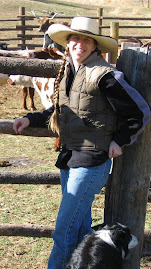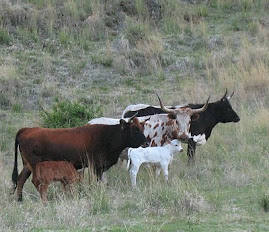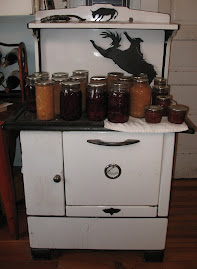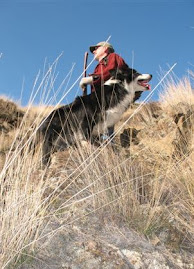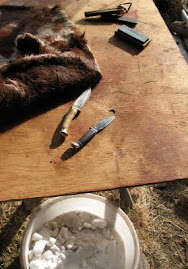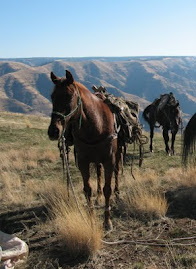Floyd Peterson’s staggering collection of junk, mostly metal scrap, was stored in and around an enormous well-weathered building next to the old Mill Pond in Enterprise. Somehow Mike figured that amongst all that junk Floyd might have a cookstove, which Floyd did, which is how for the grand sum of $25 we became proud owners of the Plymouth.
“It’s all there,” Floyd said, pointing to a pile of metal that he claimed was a functional wood stove. “We raised six kids on it and it’s been right there ever since I took it out of the house.” Mike brought the pieces home and indeed, it was all more or less there, from the somewhat-repaired firebox, to the black-trimmed white porcelain warming shelf, to the oven temperature indicator reading: “warm–slow-medium-hot-very hot.”
For twenty-five years, the Plymouth served us well. It was about as non-airtight as it gets and wouldn’t hold a fire for more than an hour (well, maybe longer if you put some apple wood in it). At baking temperature, the inside of the oven would be 500 degrees in the left rear corner and 300 degrees in the right front. If you forgot and set something breakable on the warming tray, it would soon vibrate toward the edge as people walked past and then fall off and shatter on the cast iron stove top.
In short, the Plymouth was a beloved fixture in our otherwise frigid farmhouse. The center of every winter morning, and every holiday gathering, loaded with simmering and baking foods, a place to dry out and warm up after cold, tiring work, the Plymouth was like an alter in the middle of our lives.
Several firebox repairs and about 150 chords of wood later, we’re not exactly getting rid of the Plymouth, we’re just putting her into semi-retirement. We’re modernizing. For our thirtieth wedding anniversary Mike gave me a brand-new modern, efficient, wood cookstove. As of this very moment, all six hundred pounds of the Oval are resting on the new tile hearth Mike built, hooked up to the new insulated chimney that Mike put in, burning a toasty fire of wood that Mike and Zeke harvested. She’s a beaut.
The old Plymouth hasn’t quite made it out of the kitchen yet, but will likely head to the canyon to take up a service in the ranch bunkhouse. She’ll need a new firebox first. And the bunkhouse needs new sills, a chimney, a door…it could be a few years. But that’s okay. If there’s one thing I’ve learned, it’s that a useable cookstove is worth hanging onto.
From Magpie Ranch, home of Bunchgrass Beef
Wednesday, November 18, 2009
Monday, November 9, 2009
Hairy Lucy
She didn't start out that way. When Prairie and I took pick of the litter, Lucita La Luz was a silky sweet pup with prick ears. We chose her for her confirmation and personality, which we hoped mirrored her grandmother, Bonnie, one of our favorite dogs.
Lucy joined the pack, at that time consisting of Oso, Bonnie and Chili, and assumed her role of relentlessly harassing the older dogs. Since she was too young to work, she did her best to herd the other canines at the ranch, racing ahead to cut them off and nipping at their legs, necks and shoulders. She was a colossal pest. But since all the other dogs had exhibited this same behavior as pups, they tolerated her or sent her packing with a no-nonsense growl.
When Lucy was about a year old, she and I were walking the fields behind the farmhouse when a coyote popped up from the marsh and loped off across the stubble. Lucy spotted him and took off like a rocket. I let her go, thinking this would be a good time to work on a call back, to get her to break her focus and listen to me. The coyote was a long ways off and I knew there was little chance of her ever getting close to it.
Her speed was unbelievable. I was so impressed that I just let her run. As I watched her churn across the field in a cloud of dust, it reminded me of the old roadrunner cartoons. She was humming.
I came to my senses and called her back, whistling long and sharp into the morning. When she heard me, she turned and ran all the way back to where I waited at the pond. She galloped up, tongue lolling, flashing a smile as if to say, "Now that was fun."
Lucy taught me an important lesson about communication. She was a pup when Zeke was in grade school and he loved to call her into his lap, where she would jump all over him and lick his face. As she grew older, this behavior transformed into a tightly coiled, forty-pound leap launched at your face as you walked across the yard. I hated it. Visitors like it even less.
I tried everything to break this habit, but nothing worked. Finally after two years, it clicked. She was not misbehaving, she was obeying a command. Zeke had trained her to "give kisses" and the command for this action was to look down at her and make eye contact. As soon as I figured this out, I stopped giving the command. When she bounced over to me in the morning, I looked straight ahead, said, "Sit" and held my hand out flat at my side.
At first she would sit obediently, but when I then tipped my head to look at her, she would jump, bam, teeth-first into my face. So I tried looking straight ahead and then petting her without looking down. It worked. I asked others to do the same and after a year she stopped jumping up altogether. It's amazing what we teach each other without meaning to.
Lucy was about four when she went to graduate school. She and Mike headed to the US Sheep Experiment Station in Dubois, Idaho where they grazed sheep on knapweed and developed protocols for controlling invasive species using livestock. Lucy was our first dog who could work both sheep and cattle.
Back in Wallowa County, she worked hard and eventually retired at age ten. The older she got the hairier she got. Her undercoat grew more and more dense and she never seemed to shed out all the way. Combing and brushing helped, but she was still a magnet for burrs and seeds. After two expensive trips to the vet to remove foxtail embedded in her abdomen, I took to shaving her each spring. When several friends appeared on the scene with dogs that were also named "Lucy", she became first Big Lucy and then Hairy Lucy.
In her last chapter of life, Lucy was the grandkid dog, the sweet old beast that would stand while one-year-old Dawson patted her back and grabbed handfuls of her ruff. As long as she got a chance to snake a tongue in his face every now and then, she was happy to put up with him.
Saturday Lucy went to meet her maker. Zeke and I dug the hole and the younger dogs, Newt and Ruby, came over to give her one last sniff. I laid my hand on her back, "Lucy, you were a good dog," I said. "Ashes to ashes and dust to dust," said Zeke.
If anybody comes over to pay their respects, you can find Lucy's final resting place out back in the dog cemetery next to the native grass nursery. Her's is the one with the deep red basalt stone.
From the Magpie Ranch, home of Bunchgrass Beef
Lucy joined the pack, at that time consisting of Oso, Bonnie and Chili, and assumed her role of relentlessly harassing the older dogs. Since she was too young to work, she did her best to herd the other canines at the ranch, racing ahead to cut them off and nipping at their legs, necks and shoulders. She was a colossal pest. But since all the other dogs had exhibited this same behavior as pups, they tolerated her or sent her packing with a no-nonsense growl.
When Lucy was about a year old, she and I were walking the fields behind the farmhouse when a coyote popped up from the marsh and loped off across the stubble. Lucy spotted him and took off like a rocket. I let her go, thinking this would be a good time to work on a call back, to get her to break her focus and listen to me. The coyote was a long ways off and I knew there was little chance of her ever getting close to it.
Her speed was unbelievable. I was so impressed that I just let her run. As I watched her churn across the field in a cloud of dust, it reminded me of the old roadrunner cartoons. She was humming.
I came to my senses and called her back, whistling long and sharp into the morning. When she heard me, she turned and ran all the way back to where I waited at the pond. She galloped up, tongue lolling, flashing a smile as if to say, "Now that was fun."
Lucy taught me an important lesson about communication. She was a pup when Zeke was in grade school and he loved to call her into his lap, where she would jump all over him and lick his face. As she grew older, this behavior transformed into a tightly coiled, forty-pound leap launched at your face as you walked across the yard. I hated it. Visitors like it even less.
I tried everything to break this habit, but nothing worked. Finally after two years, it clicked. She was not misbehaving, she was obeying a command. Zeke had trained her to "give kisses" and the command for this action was to look down at her and make eye contact. As soon as I figured this out, I stopped giving the command. When she bounced over to me in the morning, I looked straight ahead, said, "Sit" and held my hand out flat at my side.
At first she would sit obediently, but when I then tipped my head to look at her, she would jump, bam, teeth-first into my face. So I tried looking straight ahead and then petting her without looking down. It worked. I asked others to do the same and after a year she stopped jumping up altogether. It's amazing what we teach each other without meaning to.
Lucy was about four when she went to graduate school. She and Mike headed to the US Sheep Experiment Station in Dubois, Idaho where they grazed sheep on knapweed and developed protocols for controlling invasive species using livestock. Lucy was our first dog who could work both sheep and cattle.
Back in Wallowa County, she worked hard and eventually retired at age ten. The older she got the hairier she got. Her undercoat grew more and more dense and she never seemed to shed out all the way. Combing and brushing helped, but she was still a magnet for burrs and seeds. After two expensive trips to the vet to remove foxtail embedded in her abdomen, I took to shaving her each spring. When several friends appeared on the scene with dogs that were also named "Lucy", she became first Big Lucy and then Hairy Lucy.
In her last chapter of life, Lucy was the grandkid dog, the sweet old beast that would stand while one-year-old Dawson patted her back and grabbed handfuls of her ruff. As long as she got a chance to snake a tongue in his face every now and then, she was happy to put up with him.
Saturday Lucy went to meet her maker. Zeke and I dug the hole and the younger dogs, Newt and Ruby, came over to give her one last sniff. I laid my hand on her back, "Lucy, you were a good dog," I said. "Ashes to ashes and dust to dust," said Zeke.
If anybody comes over to pay their respects, you can find Lucy's final resting place out back in the dog cemetery next to the native grass nursery. Her's is the one with the deep red basalt stone.
From the Magpie Ranch, home of Bunchgrass Beef
Subscribe to:
Posts (Atom)


